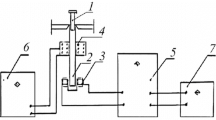Abstract
We construct an equation for the fatigue crack growth rate in strain-hardening materials and propose a method for the determination of its parameters. By using the method of limiting interpolation, we develop a procedure of approximate evaluation of the stress intensity factors near cracks originating from a hole reinforced with an elastic stringer and present examples of numerical analysis of the process of fatigue fracture.
Similar content being viewed by others
REFERENCES
V. V. Panasyuk, O. E. Andreikiv, and V. Z. Parton, Foundations of the Fracture Mechanics of Materials [in Russian], Naukova Dumka, Kiev (1988).
O. E. Andreikiv and O. I. Darchuk, Fatigue Fracture and Durability of Structures [in Russian], Naukova Dumka, Kiev (1992).
A. Carpinteri (editor), Handbook of Fatigue Crack Propagation in Metallic Structures, Vol. 2, Elsevier, Amsterdam (1994).
O. N. Romaniv, S. Ya. Yarema, H. M. Nykyforchyn, et al., Fatigue and Cyclic Crack Resistance of Structural Materials [in Russian], Naukova Dumka, Kiev (1990).
G. P. Cherepanov, Mechanics of Brittle Fracture [in Russian], Nauka, Moscow (1974).
Y. C. Li and N. C. Huang, “Fatigue crack speed of materials with linear hardening,” Int. J. Solids Struct., 27, No. 7, 865–883 (1991).
O. E. Andreikiv and M. V. Lishchyns'ka, “Kinetics of growth of fatigue cracks and residual service life of welded plates,” in: Fracture Mechanics of Materials and Strength of Structures [in Ukrainian], Vol. 3, Kamenyar, Lviv (1999), pp. 99–104.
M. Shata and Z. O. Terlets'ka, “Energy approach in the mechanics of fatigue propagation of macrocracks,” in: Fracture Mechanics of Materials and Strength of Structures [in Ukrainian], Vol. 2, Kamenyar, Lviv (1999), pp. 141–148.
V. V. Panasyuk, O. E. Andreikiv, O. I. Darchuk, and P. S. Kun, “Analysis of short and long fatigue crack growth kinetics under nonregular loading,” in: “Structural Integrity: Experiments, Models, and Applications,” Vol. 2, EMAS, Berlin (1994), pp. 1271–1276.
O. E. Andreikiv, Fracture of Quasibrittle Cracked Bodies in the Complex Stressed State [in Russian], Naukova Dumka, Kiev (1979).
O. L. Bowie, “Analysis of infinite plate containing radial crack originating at the boundary of an internal circular hole,” J. Math.Phys., 35, No. 1, 60–71 (1956).
H. Nisitani and M. Isida, “Stress intensity factor of a tensioned infinite plate with elliptical hole containing two symmetrical edge cracks,” Trans. Jap. Soc. Mech. Eng., 39, No. 317, 7–14 (1973).
H. Nisitani, K. Saito, and N. Hara, “Stress concentration in the region of elliptical holes and cracks (tension and longitudinal shear),” Trans. Jap. Soc. Mech. Eng., 39, No. 324, 2312–2322 (1973).
V. Z. Parton and E. M. Morozov, Mechanics of Elastoplastic Fracture [in Russian], Nauka, Moscow (1985).
O. E. Andreikiv, I. I. Luchko, and T. V. Gembara, “Methods for the evaluation of the stress intensity factors for cracks orthogonal to reinforcing rods,” in: Mechanics and Physics of Fracture of Composite Materials and Structures [in Russian], Uzhgorod (1988), p. 3.
V. V. Panasyuk, Mechanics of Quasibrittle Fracture of Materials [in Russian], Naukova Dumka, Kiev (1991).
S. Ya. Yarema, G. S. Krestin, and A. I. Zboromirskii, “Opening displacement and limiting equilibrium of a crack in an elastoplastic disk,” Fiz.-Khim. Mekh. Mater., 11, No. 1, 31–36 (1975).
V. V. Bozhydarnyk and H. T. Sulym, Elements of the Theory of Elasticity [in Ukrainian], Svit, Lviv (1994).
M. Savruk and V. Kravets', “Reinforcement of cracked plates with elastic patches,” in: Proc. of the Shevchenko Scientific Society [in Ukrainian], Vol. 1(1997), pp. 494–512.
M. P. Savruk, Stress Intensity Factors in Cracked Bodies [in Russian], Naukova Dumka, Kiev (1988).
Author information
Authors and Affiliations
Rights and permissions
About this article
Cite this article
Bozhydarnyk, V.V., Sulym, H.T. Effect of Reinforcements on the Fatigue Fracture of Strain-Hardening Plates with Cracked Holes. Materials Science 36, 795–809 (2000). https://doi.org/10.1023/A:1011344101590
Issue Date:
DOI: https://doi.org/10.1023/A:1011344101590



